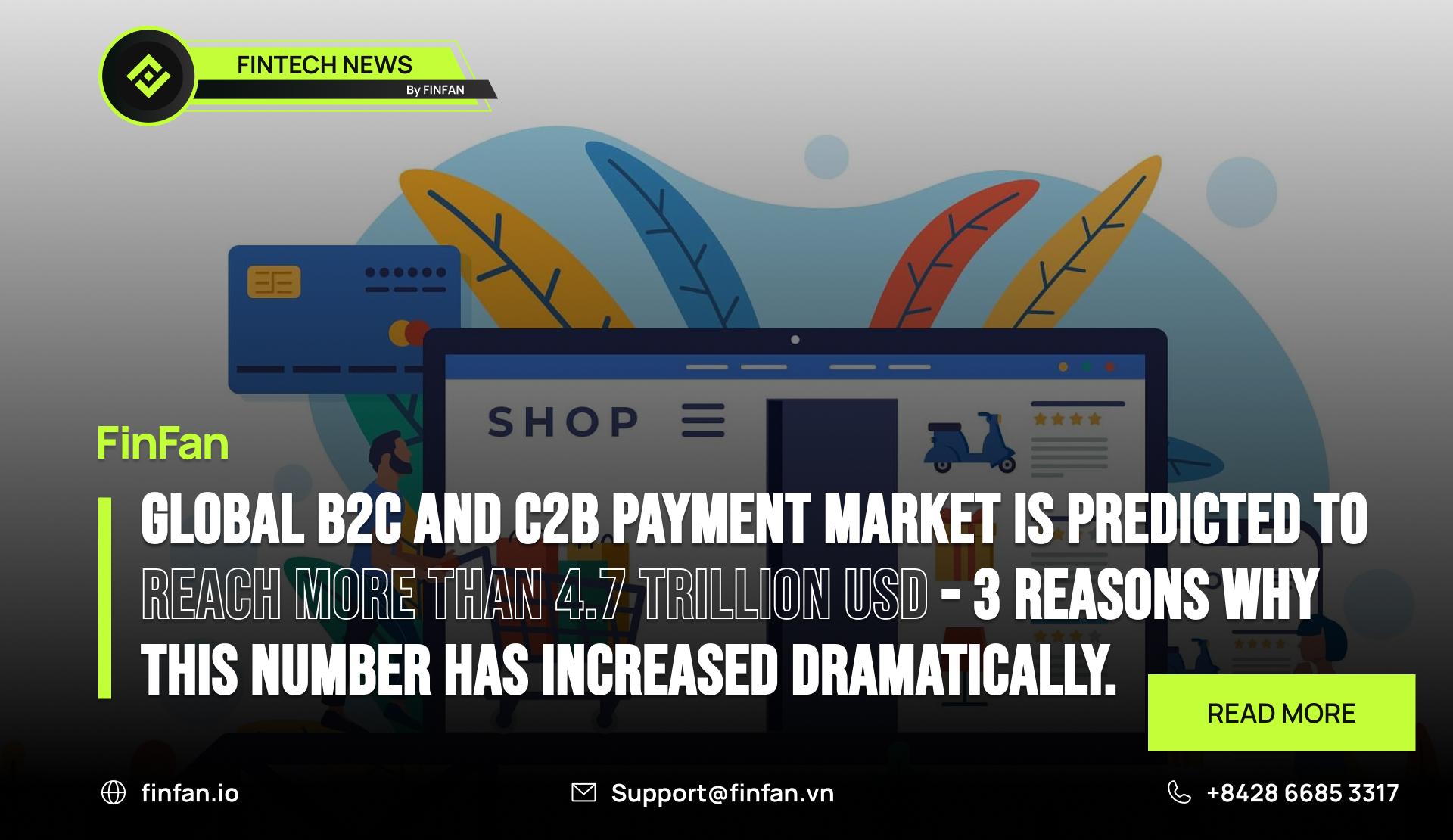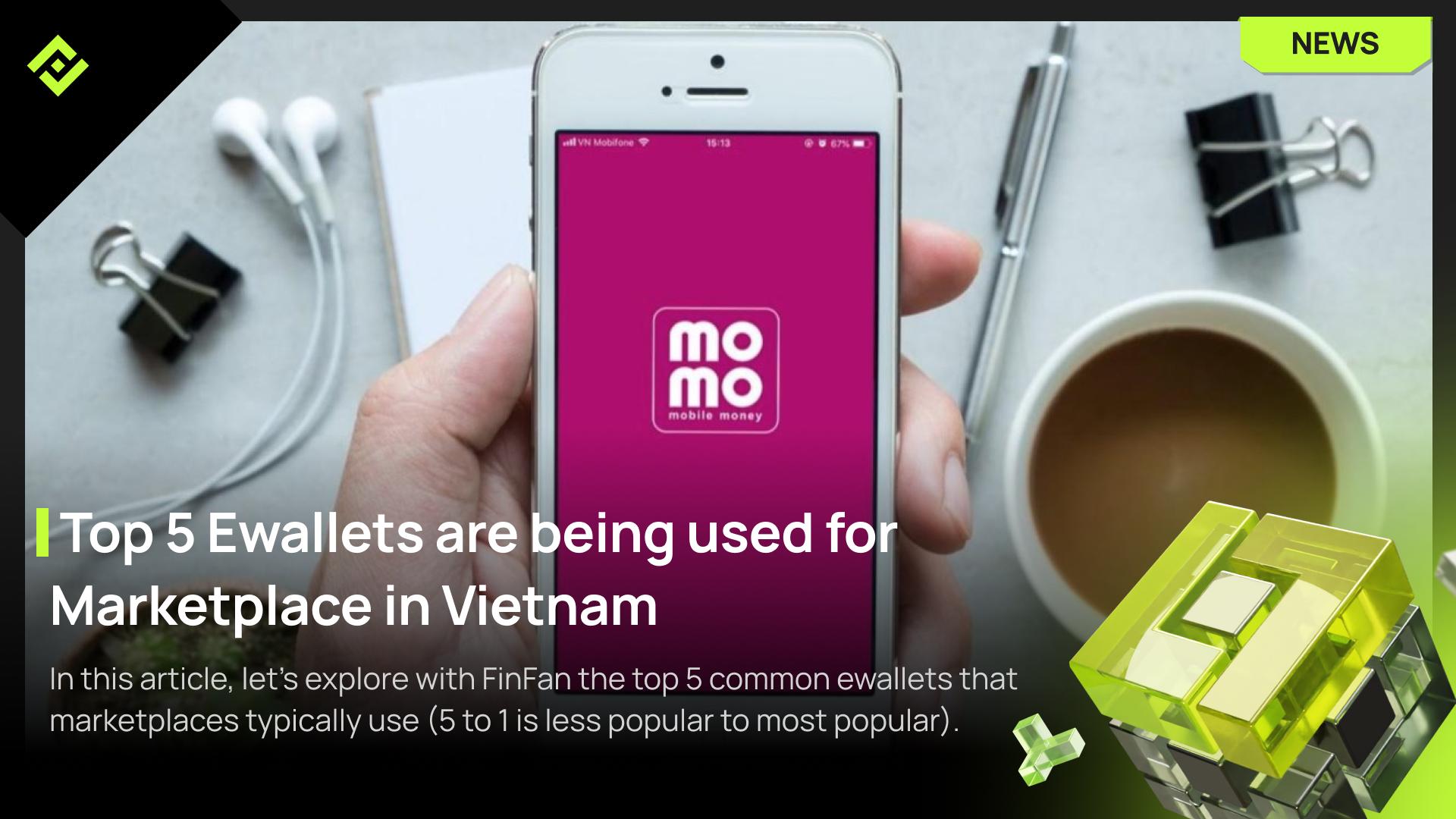B2C and C2B Payments Part 1 - Global B2C and C2B Payment Market is Predicted to Reach More Than 4.7 trillion USD - 3 reasons why this number has increased dramatically.

According to data from a study by the evaluation site specializing in research and data analysis, Allied Market Research predicts that the global B2C Payment Market will reach the milestone of 4.7 trillion dollars by 2032.
Today, let's join FinFan to learn about B2C payment and analyze the reasons why it is predicted to grow so impressively by 2032.
First, let's learn about B2C and C2B payments with FinFan
What is B2C Payment?
B2C payments are transactions that businesses have to pay for individuals who generate cash flow for them, such as employees, customers, shareholders, etc.
If these transactions are made across borders, it will be called B2C cross-border payment.
Example of B2C cross-border payment
- Pay cashback to customers.
Some online selling businesses often apply cashback policies for their loyal customers. This helps customers easily choose their favorite items and receive a partial refund (% depends on the program the brand offers).
The business that supports this service for sellers is ShopBack.
- Pay salaries/ commissions/ insurances for employees/ collaborators.
This happens often with large international corporations with branches in many countries around the world such as Apple, Google, Amazon.
Or simply, online shop owners who apply the drop shipping sales or global affiliate marketing campaigns method often have to pay commissions to collaborators who make these sales for them.
The prominent business supporting this service is Thunes in cooperation with FinFan), it has carried out many transactions from large corporations to end employees in Vietnam).
- Pay investment interest to investors.
This often happens with international stock purchases, where when the transaction is profitable, investors often apply a withdrawal order to the bank account of the country in which they live.
Or another case happens to companies that call for international crowdfunding and will have to pay profits to their angel investors in the beginning.
What is C2B payment?
In contrast to B2C payments, C2B payments are payments that individuals must pay to bring cash flow to the business and receive a certain benefit (product or profit, etc.)
If these transactions are made across borders, it will be called C2B cross-border payment.
Example of C2B cross-border payment
- Pay for products when purchased on online marketplaces or e-commerce exchanges.
This type of payment is still growing very strongly and is being invested in by many big players in the market, notably PayPal, AliPay, etc.
In particular, PayPal also develops its own stablecoin to support customers and merchants who can pay with their PYUSD stablecoin.
- Payment for top-up phones as well as telecommunications networks for users abroad
For example, you go to a certain country to travel but only need to use 5G mobile network to connect to the internet and use smartphone utilities.
Or you are exporting labor to other countries and wants to support your family in paying monthly living bills in your home country.
At this time, choosing a party that specializes in providing mobile network top-up payment services is very necessary.
Understanding the above problem, FinFan has researched and developed corresponding products to support top-up service providers as above to connect with OTAs specializing in travel to bring that convenient solution to users for using during international travel.
- Transfer money to international entertainment services or international asset exchanges.
This appears when you need to pay accounts on entertainment sites like Netflix, YouTube, etc. At the same time, for an international investor, they also have a payment method to help them deposit and withdraw money on international asset investment platforms.
So, we have partly understood the concept as well as the applications of B2C and C2B payments not only domestically but also cross-border.
Next, let's find out with FinFan the reasons for the strong growth of these two types of payments.
3 reasons why the number of B2C and C2B payments has increased dramatically.
C2B payments have been increasing due to
Strong increase in users’ online shopping demands after the period of COVID 19 and the economic crisis.
It can be seen that the impact of the COVID 19 pandemic is quite large on the global economy when most major economies such as China and the US are frozen and paralyzed for a long time.
In addition, the war between Ukraine and Russia after the pandemic has contributed to an economic crisis throughout 2023 in which workers across the country face a series of layoffs.
Brands now want to compete strongly in the market and are forced to offer attractive incentive programs to attract customers to use their products and services.
Furthermore, due to the impact of the above two events, physical shopping centers have more or less stopped operating and are no longer developing as before but are gradually being replaced by shopping on e-commerce platforms or marketplaces. Because of those stimulus moves combined with a long period of not being able to purchase necessary equipment, users' online shopping needs increased even more leading to the growth of the amount of C2B online payment.
A recent report by Allied Market Research shows that although the cards segment will still hold a large market share in the payment market (nearly a quarter of the market) by 2022, by 2032 the e-wallets segment will hold dominate this market with the highest CAGR of 14.5% from 2023 to 2032.
Entertainment demand is also increasing because of COVID 19 and the economic crisis.
During the period of social distancing caused by COVID 19, the demand for users of online entertainment platforms such as Netflix and YouTube increased because they could not go out and carry out normal communication activities and had to constantly stay at home due to quarantine (especially in Asian countries, typically Vietnam).
That's why the demand of payment for these entertainment services has also increased significantly. According to information from Yahoo Finance, Netflix reported profits of 1.68 billion USD and revenue of 8.5 billion USD, exceeding market predictions in the third quarter of 2023.
A number of digital payment methods have been developing rapidly.
It can be said that convenience and low cost are what online payment methods can bring to users when they need to shop or make cross-border payments.
Furthermore, the increasing collaboration of fintech companies with traditional money transfer services such as the combination of MoneyGram and FinFan has contributed to upgrading cross-border payment services by solving all payment problems. It makes international payments with just a few clicks without having to wait too long with cumbersome procedures to complete the C2B cross-border payment.
B2C payments have been increasing due to
Working online is increasing.
With the advantage of being born in a developed technology environment, young people can now comfortably work without having to go to the office. Therefore, the trend of remote working has increased significantly in recent years.
This also creates conditions for global companies to find talent working on a wider scale without having to go directly to that country (Facebook or TikTok are not headquartered in Vietnam for example).
This leads to a skyrocketing demand for salary payments to employees in many countries (especially commission salaries for affiliators).
The BFSI (Banking, Financial Services and Insurance) segment to maintain its leadership status throughout the forecast period.
As result of a report by a market research site like Allied Market Research: “By industry vertical, the BFSI segment held the highest market share in 2022, accounting for nearly one-fourth of the global B2C payment market revenue.
This is owing to increased B2C product offerings from major banking companies. However, the healthcare segment is projected to manifest the highest CAGR of 17.1% from 2023 to 2032, owing to increased digitalization in healthcare.
It can be said that it is extremely relevant that people are increasingly concerned about their health after so many incidents caused by pandemics and wars.
Especially during the COVID 19 period, many insurance companies had to pay huge amounts of money to their customers when their loved ones passed away.
Brands' cashback policies will be launched continuously to promote repeat purchases.
As customer demand has returned, brands now have to apply more incentives to attract their own potential and loyal customers. One of them is the cashback model, which is used a lot by global fashion brands like H&M and Zara.
According to a report by a market research site such as Market Growth Report: “Global Cashback and Rewards App market size was valued at USD 3325.9 million in 2022 and is expected to expand at a CAGR of 6.99% during the forecast period, reaching USD 4989.69 million by 2028.”
Above are some analyzing from FinFan about B2C and C2B payments. Stay updated with more information related to the world of fintech, payment, digital assets, and remittance on FinFan's official pages.
This article was curated and authored by FinFan's market research and development team, alongside our marketing department.
About FinFan
FinFan is a cross-border embedded financial services company that focuses on mass disbursement, fund collection, card processing, IBAN, and digital APMs solutions, which can provide valuable input and integration on and for the same. FinFan already integrated with almost the world's well-known MTOs, PSPs, switch and core fintech platforms as Money Gram, Thunes, Qiwi, Remitly, World Remit, Bancore, PaySend, Terrapay, Ria Money Transfer (Euronet), Dlocal, Ripple, TripleA, FoMo Pay, Wings, etc.
For more information, please contact us through:
🌐https://finfan.io
📞(+84) 2866 85 3317
✉ support@finfan.vn
LinkedIn: FinFan





